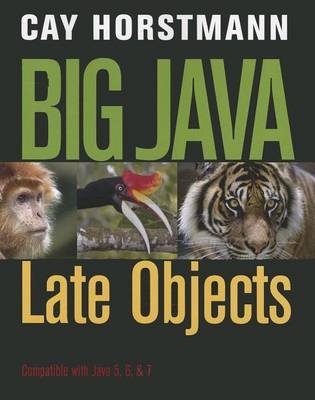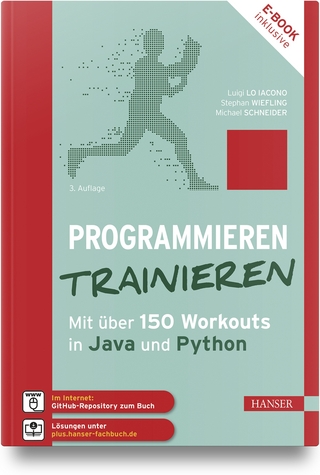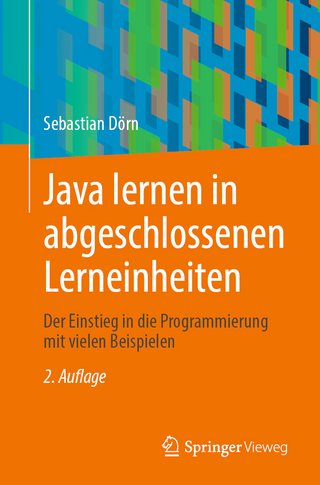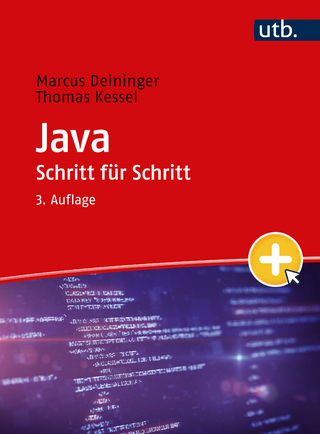
Big Java
John Wiley & Sons Inc (Verlag)
978-1-118-08788-6 (ISBN)
Cay S. Horstmann is a Professor of Computer Science in the Department of Computer Science at San Jose State University. He is an experienced professional programmer and was Vice President and Chief Technology Officer for Preview Systems, Inc. He is also a consultant for major corporations, universities, and organizations on Java, C++, Windows, and Internet programming. Horstmann is the author of many successful professional and academic books, including Big C++, C++ for Everyone, Big Java, and Big Java: Late Objectsall with John Wiley & Sons, Inc.
Preface v Special Features xxvi Chapter 1 INTRODUCTION 1 1.1 Computer Programs 2 1.2 The Anatomy of a Computer 3 1.3 The Java Programming Language 5 1.4 Becoming Familiar with Your Programming Environment 8 1.5 Analyzing Your First Program 12 1.6 Errors 15 1.7 Problem Solving: Algorithm Design 16 Chapter 2 FUNDAMENTAL DATA TYPES 29 2.1 Variables 30 2.2 Arithmetic 41 2.3 Input and Output 48 2.4 Problem Solving: First Do It By Hand 57 2.5 Strings 59 Chapter 3 DECISIONS 81 3.1 The if Statement 82 3.2 Comparing Numbers and Strings 88 3.3 Multiple Alternatives 96 3.4 Nested Branches 100 3.5 Problem Solving: Flowcharts 105 3.6 Problem Solving: Test Cases 108 3.7 Boolean Variables and Operators 111 3.8 Application: Input Validation 116 Chapter 4 LOOPS 139 4.1 The while Loop 140 4.2 Problem Solving: Hand-Tracing 147 4.3 The for Loop 150 4.4 The do Loop 156 4.5 Application: Processing Sentinel Values 158 4.6 Problem Solving: Storyboards 162 4.7 Common Loop algorithms 165 4.8 Nested Loops 172 4.9 Application: Random Numbers and Simulations 176 Chapter 5 METHODS 201 5.1 Methods as Black Boxes 202 5.2 Implementing Methods 204 5.3 Parameter Passing 207 5.4 Return Values 210 5.5 Methods Without Return Values 214 5.6 Problem Solving: Reusable Methods 215 5.7 Problem Solving: Stepwise Refinement 218 5.8 Variable Scope 225 5.9 Recursive Methods (Optional) 228 Chapter 6 ARRAYS AND ARRAY LISTS 249 6.1 Arrays 250 6.2 The Enhanced for Loop 257 6.3 Common Array Algorithms 258 6.4 Using Arrays with Methods 268 6.5 Problem Solving: Adapting Algorithms 272 6.6 Problem Solving: Discovering Algorithms by Manipulating Physical Objects 279 6.7 Two-Dimensional Arrays 282 6.8 Array Lists 289 Chapter 7 INPUT/OUTPUT AND EXCEPTION HANDLING 317 7.1 Reading and Writing Text files 318 7.2 Text Input and Output 323 7.3 Command Line Arguments 330 7.4 Exception Handling 337 7.5 Application: Handling Input Errors 347 Chapter 8 OBJECTS AND CLASSES 361 8.1 Object-Oriented Programming 362 8.2 Implementing a Simple Class 364 8.3 Specifying the Public Interface of a Class 367 8.4 Designing the Data representation 371 8.5 Implementing Instance Methods 372 8.6 Constructors 375 8.7 Testing a Class 380 8.8 Problem Solving: Tracing Objects 386 8.9 Problem Solving: Patterns for Object Data 388 8.10 Object References 395 8.11 Static Variables and Methods 400 Chapter 9 INHERITANCE AND INTERFACES 415 9.1 Inheritance Hierarchies 416 9.2 Implementing Subclasses 420 9.3 Overriding Methods 424 9.4 Polymorphism 430 9.5 Object: The Cosmic Superclass 441 9.6 Interface Types 448 Chapter 10 GRAPHICAL USER INTERFACES 465 10.1 Frame Windows 466 10.2 Events and Event Handling 470 10.3 Processing Text Input 481 10.4 Creating Drawings 487 Chapter 11 ADVANCED USER INTERFACES 507 11.1 Layout Management 508 11.2 Choices 510 11.3 Menus 521 11.4 Exploring the Swing Documentation 528 11.5 Using Timer events for Animations 533 11.6 Mouse Events 536 Chapter 12 OBJECT-ORIENTED DESIGN 549 12.1 Classes and Their Responsibilities 550 12.2 Relationships Between Classes 554 12.3 Application: Printing an Invoice 562 12.4 Packages 574 Chapter 13 RECURSION 585 13.1 Triangle Numbers Revisited 586 13.2 Problem Solving: Thinking Recursively 590 13.3 Recursive Helper Methods 594 13.4 The Efficiency of Recursion 596 13.5 Permutations 601 13.6 Mutual Recursion 606 13.7 Backtracking 612 Chapter 14 SORTING AND SEARCHING 627 14.1 Selection Sort 628 14.2 Profiling the Selection Sort Algorithm 631 14.3 Analyzing the Performance of the Selection Sort Algorithm 634 14.4 Merge Sort 639 14.5 Analyzing the Merge Sort Algorithm 642 14.6 Searching 646 14.7 Problem Solving: Estimating the Running Time of an Algorithm 651 14.8 Sorting and Searching in the Java Library 656 Chapter 15 THE JAVA COLLECTIONS FRAMEWORK 669 15.1 An Overview of the Collections Framework 670 15.2 Linked Lists 672 15.3 Sets 679 15.4 Maps 684 15.5 Stacks, Queues, and Priority Queues 690 15.6 Stack and Queue Applications 693 Chapter 16 BASIC DATA STRUCTURES 713 16.1 Implementing Linked Lists 714 16.2 Implementing Array Lists 728 16.3 Implementing Stacks and Queues 733 16.4 Implementing a Hash Table 739 Chapter 17 TREE STRUCTURES 759 17.1 Basic Tree Concepts 760 17.2 Binary Trees 764 17.3 Binary Search Trees 769 17.4 Tree Traversal 778 17.5 Red-Black Trees 784 17.6 Heaps 791 17.7 The Heapsort Algorithm 802 Chapter 18 GENERIC CLASSES 817 18.1 Generic Classes and Type Parameters 818 18.2 Implementing Generic Types 819 18.3 Generic Methods 823 18.4 Constraining Type Parameters 825 18.5 Type Erasure 829 Chapter 18 STREAMS AND BINARY INPUT/OUTPUT 839 19.1 Readers, Writers, and Streams 840 19.2 Binary Input and Output 841 19.3 Random Access 845 19.4 Object Streams 851 Chapter 20 MULTITHREADING (WEB ONLY) 20.1 Running Threads 20.2 Terminating Threads 20.3 Race Conditions 20.4 Synchronizing Object Access 20.5 Avoiding Deadlocks 20.6 Application: Algorithm Animation Chapter 21 INTERNET NETWORKING (WEB ONLY) 21.1 The Internet Protocol 21.2 Application Level Protocols 21.3 A Client Program 21.4 A Server Program 21.5 URL Connections Chapter 22 RELATIONAL DATABASES (WEB ONLY) 22.1 Organizing Database Information 22.2 Queries 22.3 Installing a Database 22.4 Database Programming in Java 22.5 Application: Entering an Invoice Chapter 23 XML (WEB ONLY) 23.1 XML Tags and Documents 23.2 Parsing XML Documents 23.3 Creating XML Documents 23.4 Validating XML Documents Chapter 24 WEB APPLICATIONS (WEB ONLY) 24.1 The Architecture of a Web Application 24.2 The Architecture of a JSF Application 24.3 Javabeans Components 24.4 Navigation Between Pages 24.5 JSF Components 24.6 A Three-Tier Application APPENDICES APPENDIX A THE BASIC LATIN AND LATIN-1 SUBSETS OF UNICODE 861 APPENDIX B JAVA OPERATOR SUMMARY 865 APPENDIX C JAVA RESERVED WORD SUMMARY 867 APPENDIX D THE JAVA LIBRARY 869 APPENDIX E JAVA SYNTAX SUMMARY 913 APPENDIX F HTML SUMMARY 925 APPENDIX G TOOL SUMMARY 931 APPENDIX H JAVADOC SUMMARY 933 APPENDIX I NUMBER SYSTEMS 935 APPENDIX J BIT AND SHIFT OPERATIONS 941 APPENDIX K UML SUMMARY 943 APPENDIX L JAVA LANGUAGE CODING GUIDELINES 947 GLOSSARY 955 INDEX 969 CREDITS 1011
| Erscheint lt. Verlag | 20.2.2012 |
|---|---|
| Verlagsort | New York |
| Sprache | englisch |
| Maße | 210 x 254 mm |
| Gewicht | 2580 g |
| Themenwelt | Informatik ► Programmiersprachen / -werkzeuge ► Java |
| Informatik ► Software Entwicklung ► Objektorientierung | |
| ISBN-10 | 1-118-08788-7 / 1118087887 |
| ISBN-13 | 978-1-118-08788-6 / 9781118087886 |
| Zustand | Neuware |
| Haben Sie eine Frage zum Produkt? |
aus dem Bereich


